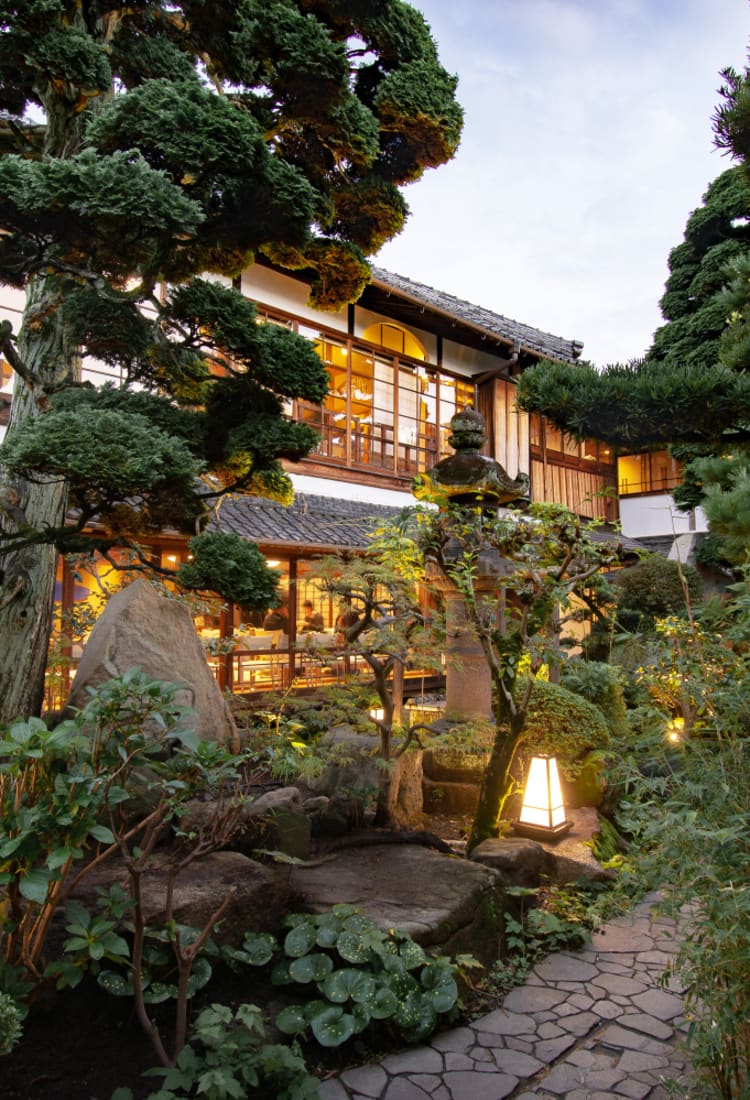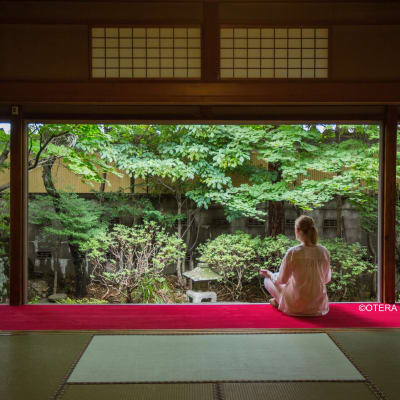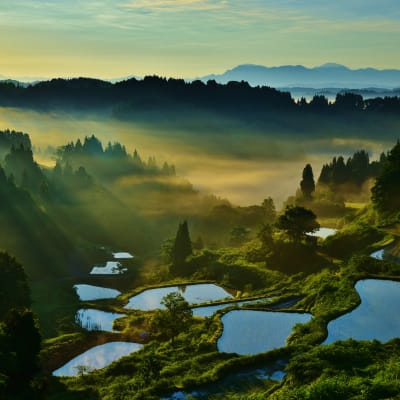
Nipponia Hotel Igaueno Castle Town Immerse Yourself in History
Stay in a beautifully restored historic mansion in the center of an ancient ninja stronghold
Iga is a charming castle town in the mountains of Mie Prefecture, about an hour and a half southeast of Kyoto. It is home to the imposing Iga Ueno Castle, originally constructed in 1585, and known as the “White Phoenix” for its beauty and structure. The town is concealed by densely forested mountains and served as the base for the stealthy Iga-ryu school of ninjas in the fifteenth century. Nipponia Hotel Igaueno Castle Town offers guests the rare opportunity to immerse themselves in this fascinating area, staying in restored houses and former shops around the town. The whole town serves as your hotel, with the knowledgeable staff serving as guides to the culture and heritage of the area.
Restoring and reviving a historic town
Iga’s history makes it the ideal location for a hotel that blends historical buildings with luxurious design. It was once a thriving post town (rest stop) on a major route between Osaka and Nagoya during the Edo period (1603–1867). Over time, an aging population and migration to larger cities led to many of Iga’s traditional buildings being left empty and neglected. The first stage of Nipponia Hotel Igaueno Castle Town opened in late 2020 with a mission to reinvigorate the town and restore some of its beautiful heritage properties from the Edo period (1603–1867) and the Meiji, Taisho, and Showa eras (1868–1989).


Stay in one of the beautifully restored properties in the town.
So far, Nipponia Hotel has restored three buildings, creating ten beautifully appointed guest rooms around Iga’s historical district. These are all within easy walking distance of each other and convenient to Uenoshi Station, encouraging deeper exploration of the town. There are plans to expand the hotel further in the future, reinvigorating more of the town’s historic buildings. The hotel staff is passionate about the area, advising guests on the best local eateries and charming streets to explore. They can organize tailored experiences to help you connect with the culture and natural beauty of the Iga area, from visits to artisan ateliers, to relaxing in an outdoor hot spring.
Live like a local
The streets of Iga Ueno are lined with period properties that hark back to a bygone Japan. Kanmuri, the main building of the Nipponia Hotel, functions as a reception and restaurant, just five minutes from Uenoshi Station on foot. The building is a registered Tangible Cultural Property of Japan. It served as an herbal medicine wholesaler during the Edo period (1603–1867) and later as a restaurant and an educational facility. Three of the hotel’s rooms are located in Kanmuri, which has been renovated with a light touch to preserve its period details. Local designers and artisans have provided much of the flair in this stylish property, such as folk art paintings, hand-crafted furniture, and tactile walls decorated with a local raised plaster technique called “tsutsumi tsunagi.”


The spacious rooms retain their traditional atmosphere, with modern comforts.
The hotel’s second building, Kourai, is a 5-minute walk away. Kourai was a hardware store during the Meiji era (1868–1912) and was lovingly renovated by Kirin, an Iga-based architectural firm. The project saved the property from falling into disrepair and elevated it to a seriously stylish accommodation of several spacious guest rooms with beamed ceilings, red-eye pine finishes and a beautifully landscaped Japanese garden. Rooms are decorated with artworks created by Gallery Yamahon, owned by locally born architect and gallerist, Yamamoto Tadaomi.
A third building is scheduled to be completed and open for guests from spring 2021.
Iga’s hidden gastronomic heritage
Iga’s location, almost hidden from the outside world in a basin surrounded by densely forested mountains, has created the ideal conditions for its farming and food culture, just as it once provided a concealed base for its storied ninja. Now, the town attracts international attention for its Koshihikari rice, elegant sake, and exceptional wagyu beef. Iga beef is produced in such limited quantities that most of it stays in the region. Intrepid foodies make the trip to Iga just to sample this rare delicacy.
The staff at Nipponia Hotel Igaueno Castle Town is deeply connected with the area and can advise you on the best restaurants to experience local flavors. The property’s own restaurant, Le Un, serves Japanese French fusion cuisine that emphasizes the exceptional quality of the ingredients produced in Iga.

Dine on local specialties including Iga beef, at the hotel restaurant Le Un.
The airy, elegant dining room is minimally decorated, with tatami flooring and simple wooden furniture, allowing the structure of the historic room and views of the gardens to garner all the attention.
As part of the hotel’s community-collaborative approach, the people of Iga were consulted about typical Iga dishes and flavors, and these elements were incorporated into the menu. Small dishes of seasonal local ingredients balance the elegance of French dining with the attention to detail of traditional kaiseki cuisine. The beef is a must-try: It is said that in the fourteenth century, Iga ninjas ate dried Iga beef for stamina and strength.
Exploring the ancient castle town
Iga Ueno Castle is an impressive fortress in Ueno Park, a 15-minute walk from the Kanmuri building. The castle is referred to as “Hakuho,” or “White Phoenix,” for its elegant, wing-like architecture. The original was built in the sixteenth century and expanded in the seventeenth century. The current castle keep is a twentieth-century reconstruction, recreated in wood, not concrete, giving it an authentic feel. Within the castle, a small museum exhibits samurai armor and artifacts. A helmet on display was given to Takatora Todo (1556–1630), the lord of Iga Ueno Castle, by Hideyoshi Toyotomi (1537–1598), a powerful Japanese warlord, famous for unifying Japan in the late sixteenth century.

The impressive facade of Iga Ueno Castle
The Iga Ninja Museum is also on the castle grounds. It provides a comprehensive look at the town’s impressive past, training highly skilled ninjas. Among the exhibits are traditional ninja outfits and weapons. Visitors can tour a ninja house complete with escape routes and hidden doors, watch thrilling combat demonstrations, and put their ninja skills to the test, throwing shuriken (throwing stars).
For those looking for gentler pursuits, discover the town’s poetic past. Iga is the birthplace of one of Japan's greatest poets, Matsuo Basho (1644–1694), the most famous poet of the Edo period (1603–1867). His haiku poetry still resonates today. The Basho Memorial Museum, Basho’s Birth House, and Minomushi-an, the last remaining of Basho’s original five writing retreats, are all within a 15-minute walk of the hotel.
The grid-like layout of much of the town makes it easy to navigate. Stroll around the charming streets or let the hotel organize a rickshaw tour, stopping to sample local snacks. Look out for katayaki, a hard cookie made from flour and sugar, said to be based on the portable snacks that ninjas ate to keep their energy levels up. Other local snacks to try are yokan-zuke and Igagoe-zuke, types of fermented gourd usually served with rice.
Learn local crafts from skilled artisans
Immerse yourself in Iga’s craft culture with an Iga-yaki pottery class at Mitagama, a farmhouse converted into a workshop. Iga-yaki pottery is crafted from high-quality clay that attains a very hard finish when fired. The grainy, textured surface gives the pottery a rustic finish that is satisfying to hold. Iga-yaki pottery retains heat well, making it a practical material for mugs and bowls. The hotel concierge can book a one-to-two-hour workshop hosted by a skilled potter at the Iga Yaki Traditional Industry Center. The artisan will guide you through the crafting process, showing you how to knead your clay into shape or use a potter’s wheel to produce an original piece. Your creation is then dried, glazed and fired before being sent to you around a month later: a beautiful memento of your trip.

Learn about Iga-yaki pottery from a local artisan and make your own piece to take home.
Photo credit: Gallery & Accomodation MITAGAMA
Hike in the footsteps of spies and assassins
Reizan is a 766-meter mountain with a pleasant hiking trail and views across the region from the summit. Reizan Temple is about a 30-minute drive from the hotel, and stands at the trailhead of the easy hike. Take time to explore the scenic temple grounds before you ascend the mountain. Reizan Temple has hundreds of sekibutsugun, stone Buddhas on the grounds, scores of cherry trees, and an Ohatsuki ginkgo tree, designated a Prefectural Natural Monument, which towers above the temple. Look out for shuriken motifs signaling the trailhead, a much-repeated theme across Iga and a nod to its ninja history.

Reizan Temple marks the start of a pleasant hike up Reizan.
The hour-long walk along the mossy trail to the peak passes varied vegetation, including Japanese andromeda, Japanese holly, and maples. From the summit, the entire Iga basin stretches out before you, including Lake Biwa, Japan’s largest freshwater lake (in neighboring Shiga Prefecture), and Aoyama Kogen, a sweeping plateau home to a large wind farm.

Enjoy sweeping views across the plateau.
There are stone remnants of a temple that existed at the summit between the Heian and Edo periods (794–1867), where the ascetic training methods of the ninjas are believed to have originated. Enjoy the views before descending the mountain.
Relax at Oyamada Onsen
Unwind at Oyamada Onsen, a 40-minute drive from Reizan, in the nearby village of Kamiawa. There are a variety of wood and stone indoor and outdoor baths. The baths have a pH of 8.2 and are said to leave your skin feeling soft and smooth. The soothing waters will help to relieve any aches from your travels and help you unwind for a good night’s sleep.


Unwind in one of the outdoor baths at Oyamada Onsen.
Measures against the spread of COVID-19
Nipponia Hotel Igaueno Castle Town has implemented measures to ensure the health and safety of its guests and staff: All areas throughout the hotel are regularly disinfected and ventilated, alcohol disinfectants are made available in common areas, and tables in the dining area are spaced apart.


























































